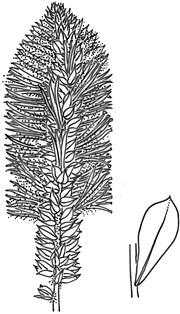Common name: Tall Mulla Mulla, Showy Foxtail
Ptilotus exaltatus Nees APNI* Synonyms: Ptilotus exaltatus Nees ex Lehm. var. exaltatus APNI*

Description: Erect annual or short-lived perennial to 1.5 m high: taproot fleshy and little-branched. Stems villous or glabrescent; hairs simple or verticillate.
Basal leaves linear-lanceolate or spathulate, 50–200 mm long, 20–60 mm wide, glabrous or sometimes with dense verticillate hairs; margins entire and sometimes undulate; apex mucronate, the mucro 1–3 mm long. Stem leaves narrowly elliptic to obovate, 5–115 mm long, 3–40 mm wide, glabrous or sometimes with dense verticillate hairs; bases sessile or subsessile; margins entire and sometimes undulate; apex mucronate to pungent with a fragile mucro 1–3 mm long.
Spike pink to purple, cylindrical, 20–200 mm long, 30–50 mm wide, sweetly scented; apex acute. Bracts ovate-lanceolate, 5–10.5 mm long; apex mucronate. Bracteoles ovate, 7.5–10.5 mm long; apex mucronate. Tepals widely gaping at anthesis, 17–22 mm long, straight, purple to pink throughout, outer surface villous with verticillate hairs, underlain by shorter, denser, and more densely branched hairs, the indumentum shorter and sparser along the midline; apex truncate-serrate, glabrous. Fertile stamens 3 or 2; filaments 9–17 mm long, unequal in length, anthers pink, 1.2–1.7 mm long. Staminodes 2 or 3, obscured by the woolly tepal hairs. Ovary obovoid, pilose or glabrous apically; stipe 1.5 mm long. Style slightly sigmoidal, 13–17 mm long.
Distribution and occurrence: Throughout arid and semi-arid Australia. It is found in a variety of habitats, including acacia shrublands, eucalyptus woodlands and grasslands, and can be found on red sands, brown or red sandy clays and calcareous loams, and on stony or gravelly sites.
NSW subdivisions: NWS, NWP, SWP, NFWP, SFWP
Other Australian states: Qld Vic. N.T. S.A. W.A.
Bean (2008) united Ptilotus nobilis and Ptilotus exaltatus, but a morphological and ecological investigation by Hammer et al. (2017) recognises both as distinct species. Ptilotus exaltatus can be readily distinguished from Ptilotus nobilis by its widely gaping, purple to pink flowers with straight tepals and a dense, woolly indumentum plug obscuring the ovary.
Text by S. W. L. Jacobs & L. Lapinpuro; updated S. McCune (July 2020)
Taxon concept: Hammer, TA et al. (2018) Australian Systematic Botany 31(3):262-280
APNI* Provides a link to the Australian Plant Name Index (hosted by the Australian National Botanic Gardens) for comprehensive bibliographic data
***The AVH map option provides a detailed interactive Australia wide distribution map drawn from collections held by all major Australian herbaria participating in the Australian Virtual Herbarium project.
|


